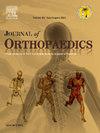Return to recreational activity after hip abductor repair: A systematic review
IF 1.5
Q3 ORTHOPEDICS
引用次数: 0
Abstract
Background
Hip abductor tears are a relatively common pathology that can impede activity and quality of life. Surgical repair may confer a greater ability to return to recreational activities; however, to our knowledge no systematic reviews have been conducted exploring this. The purpose of this study is to describe the ability to return to recreation following hip abductor repair, and identify any patient factors affecting post-surgical prognosis.
Methods
A systematic search of peer-reviewed studies published on and prior to February 15th, 2024 was conducted using Medline (Ovid), Embase, Cochrane, and CINAHL (EBSCO) in adherence with the Preferred Reporting Items for Systematic Reviews and Meta-Analyses (PRISMA) standards. The search included a combination of keywords and controlled vocabulary for the following concepts: return to recreation and hip abductor repair. Outcomes of interest included return to recreation beyond patient reported outcome measures, imaging, surgical indications, surgical methods/techniques, concomitant procedures, complications, reoperations, postoperative management, and sports related outcome scores if applicable.
Results
Across 5 studies, a total of 474 patients (41 males, 433 females) with a history of recreational activity and mean age of 69.92 years underwent repair. Two studies reported the number of patients returning to recreation, yielding a return rate of 76 %, with walking having the highest return (N = 26), and skiing, soccer, and horse-riding seeing no return. There was no difference in return based on procedural technique or concomitant procedures (P > 0.05). The most common postsurgical complication was re-tear (N = 25) for which 20 patients underwent secondary repair. Across 4 studies, there was a weighted satisfaction rate of 91.47 % with return to recreation. The fifth study reported a satisfaction score of 8 out of 10.
Conclusion
With an aging population and a growing desire to maintain elevated levels of physical activity, the importance of assessing return to recreation following hip abductor repair is increasingly crucial. This study demonstrates a relatively high satisfaction rate while also underscoring a greater need to report specific activities when discussing postsurgical return to recreation.
髋关节外展肌修复后恢复娱乐活动:一项系统回顾
髋关节外展肌撕裂是一种相对常见的病理,可妨碍活动和生活质量。手术修复可以使患者恢复娱乐活动的能力增强;然而,据我们所知,还没有对此进行过系统的综述。本研究的目的是描述髋关节外展肌修复后恢复娱乐的能力,并确定任何影响术后预后的患者因素。方法采用Medline (Ovid)、Embase、Cochrane和CINAHL (EBSCO)系统检索2024年2月15日及之前发表的同行评议研究,遵循系统评价和meta分析首选报告项目(PRISMA)标准。搜索包括以下概念的关键字和控制词汇的组合:回归娱乐和髋关节外展肌修复。关注的结果包括患者报告的结果测量、影像学、手术指征、手术方法/技术、伴随手术、并发症、再手术、术后管理和运动相关结果评分(如果适用)。结果在5项研究中,共有474例有娱乐活动史的患者(男性41例,女性433例)接受了修复手术,平均年龄为69.92岁。两项研究报告了患者恢复娱乐活动的数量,恢复率为76%,其中步行的恢复率最高(N = 26),滑雪、足球和骑马的恢复率为零。基于手术技术或伴随手术的回报没有差异(P >;0.05)。最常见的术后并发症是再撕裂(N = 25),其中20例患者接受了二次修复。在4项研究中,回归娱乐的加权满意度为91.47%。第五项研究报告满意度得分为8分(满分10分)。结论:随着人口老龄化,人们越来越希望保持较高的身体活动水平,评估髋关节外展肌修复后的娱乐恢复情况变得越来越重要。这项研究显示了相对较高的满意率,同时也强调了在讨论术后恢复娱乐活动时更需要报告具体的活动。
本文章由计算机程序翻译,如有差异,请以英文原文为准。
求助全文
约1分钟内获得全文
求助全文
来源期刊

Journal of orthopaedics
ORTHOPEDICS-
CiteScore
3.50
自引率
6.70%
发文量
202
审稿时长
56 days
期刊介绍:
Journal of Orthopaedics aims to be a leading journal in orthopaedics and contribute towards the improvement of quality of orthopedic health care. The journal publishes original research work and review articles related to different aspects of orthopaedics including Arthroplasty, Arthroscopy, Sports Medicine, Trauma, Spine and Spinal deformities, Pediatric orthopaedics, limb reconstruction procedures, hand surgery, and orthopaedic oncology. It also publishes articles on continuing education, health-related information, case reports and letters to the editor. It is requested to note that the journal has an international readership and all submissions should be aimed at specifying something about the setting in which the work was conducted. Authors must also provide any specific reasons for the research and also provide an elaborate description of the results.
 求助内容:
求助内容: 应助结果提醒方式:
应助结果提醒方式:


